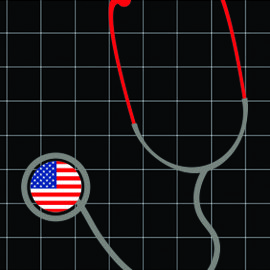Are medical school admissions really accessible in the united states?

With the weather getting chillier and holidays just now ending, Winter is finally settling in. Winter brings frost, family reunions and the end of school terms, but it also brings another, more stressful, season closer. MCAT season. As a SCAD publication, I recognize that most of our audience remains blissfully unaware of the comings and goings of medical and pre-med students. A true SCAD student myself, I tend to tune out subjects relating to math and hard sciences, so watching my partner prepare for her MCAT exam this coming January has been nothing short of revelatory. I knew the MCAT was an exclusionary practice; the test is designed to weed out students so only the best have the potential to become our future doctors and nurses. But I didn’t know how financially discriminatory the medical school application process is to potential applicants.
If a student wants to be a serious candidate for medical school in the United States, they need at least a 3.6 GPA to be considered average. That means only A’s and B’s in all prerequisite classes that are required for application to medical school, which typically includes multiple levels of biology, chemistry, physics and mathematics. This means that any paid tutoring necessary for these undergraduate courses eventually counts toward the cost of medical school admissions.
When junior year rolls around, pre-med students begin studying for the dreaded MCAT. But what is the MCAT, exactly? There have been many iterations of this standardized test since the 1900s and has looked very different over the years. It all started with the Moss test; by the 1920s, dropout rates in US medical schools exploded from 5% to 50%, which lead to the establishment of a standardized test that would evaluate preparedness for medical school. The physician F.A. Moss developed the “Scholastic Aptitude Test for Medical Students,” which consisted of true/false and multiple choice questions, and was divided into six to eight subtests. Subjects included visual memory and memory for content, scientific vocabulary and definitions, understanding of printed material, premedical content and basic logical reasoning. In accordance with stricter medical school admissions, the national dropout rate decreased to 7% in 1946.
The test underwent a massive evolution with advancements in test measurement technology, including machine scoring of tests and updated views on test scores and medical school preparedness. In this simpler form, it was made up of four subtests, including verbal ability, quantitative ability, science achievement and understanding modern society, all of which were multiple choice. Between 1946 and 1948 this version of the test was known as the Professional School Aptitude Test. When the developer of the test, the Graduate Record Office, under contract with the Association of American Medical Colleges, merged with the Educational Testing Service, the name officially changed to the Medical College Admission Test or MCAT.
By 1977, the MCAT continued to evolve, as the topics tested changed to scientific knowledge, science problems, reading skills analysis and quantitative skills analysis. They started reporting individual scores for biology, chemistry and physics rather than composite science scores. A new type of format emerged in 1991 when a majority of the multiple choice questions were divided into passage sets, which were passage-based questions that evaluated “text comprehension, data analysis, ability to evaluate an argument or apply knowledge from the passage to other contexts.” The entire testing experience changed again in 2005 when the test switched from pencil and paper to a computer-based format. The test itself has been updated numerous times since 2005, with the latest change in 2015, consisting of the addition of testing in biochemistry, psychology and sociology concepts and the removal of the writing sample.
Now, the MCAT is offered 25 or more times per year and is made up of the four following sections: Chemical and Physical Foundations of Biological Systems, Critical Analysis and Reasoning Skills, Biological and Biochemical Foundations of Living Systems and Psychological, Social and Biological Foundations of Behavior. The sections are all multiple-choice and are individually scored. Each section takes 90 or 95 minutes and proposes 50-60 questions. When breaks are included, the whole test lasts about 7.5 hours. Basically, this test is a big deal. In a study by Kaplan, an educational and training service, 54% of medical schools said that a low MCAT score is “the biggest application dealbreaker.”
So how do students even approach taking a 7.5-hour test that can make or break their acceptance into medical school? Studying. Hours and hours of studying. The Association of American Medical Colleges distributed a Post-MCAT Questionnaire in 2017 to understand the kinds of preparation students partook in before their MCAT examination. According to their survey, the average student spent 12 weeks preparing at approximately 23 hours a week solely studying for the MCAT. 77% of students used programs by a commercial company to study, which can include prep classes in-person or online, prep books, full-length practice exams, and more. 85% of test takers found MCAT prep books to be useful.
Digging a little deeper into MCAT prep, it seems that the Kaplan Inc. corporation has a monopoly on testing services and happens to be the most popular MCAT preparatory program in the United States. Their programs provide video-based lessons, 2,900+ practice problems, prep material with 700 hours worth of content and what have been considered some of the best hardcopy books in MCAT prep. Kaplan offers 4 different packages for students to choose from, with varying standards and prices. Their cheapest option, the On Demand Course, costs about $2,000. From there, the Live Online Course and In-Person Course are priced at around $2,600, with the Private Tutoring +Live Online Course costing $3299.
Now let’s say a student is able to raise the funds necessary for tutoring and puts in the hard work studying for the months leading up to the exam. There is a fee for taking the MCAT, which is a minimum of $325 and is bumped up to $375 for late registration. Those applying from countries other than the United States and Canada are obligated to pay a $115 International Registration fee in addition to the basic registration fee. Those that are unable to pay the registration fee may be able to qualify for the Fee Assistance Program, which reduces the fee to $130.
Once a student is satisfied with their MCAT scores, they can start sending them to prospective schools, which comes at a price. According to the test prep and professional training company Blueprint, “If you’re applying to M.D. schools, the American Medical College Application Service® (AMCAS) primary application fee is $171 for the first school and $41 for each additional school you apply to. To apply to D.O. schools, the American Association of Colleges of Osteopathic Medicine Application Service (AACOMAS) charges $196 for the first school and $46 for each additional school.” The 2018-2019 Association of American Medical Colleges survey found that the average number of schools applied to by applicants was 16, which would bring application fees to about $786 per student.
If an applicant passes the preliminary stage, they are invited for an interview at the campus. In-state interviews may just require the cost of professional attire, but out-of-state interviews include the costs of airfare, hotel reservations, and other accommodations. Students are expected to be able to drop everything and fly across the country, or across the world, at the drop of a hat, which, unfortunately, just isn’t realistic for most people.
A 2022 US News report cites staffing shortages as the nation’s top patient safety concern, as healthcare employment is down 1.1% compared to February 2020. US News went further to say that “the American Hospital Association called the workforce shortage hospitals are experiencing a ‘national emergency,’ projecting the overall shortage of nurses to reach 1.1 million by the end of the year. And it’s not just nurses: Professionals from medical lab workers to paramedics are in short supply.” In a time when Americans are facing longer wait times for care or are being turned away completely, it’s hard to consider the current application process, a practice that excludes low income students, to be practical or effective.



























